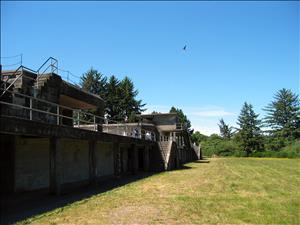On June 21, 1942, the Imperial Japanese Navy submarine I-25 shells the U.S. Army's Fort Stevens coastal defenses on the Oregon side of the mouth of the Columbia River. The Japanese are retaliating for the U.S. bombing of Japan the prior April. The U.S. batteries do not return fire and there is no serious damage.
The mouth of the Columbia River was defended by three Army forts: Fort Stevens on the Oregon side and Forts Canby and Columbia on the Washington side. In 1942, Coast Artillery and National Guard units manned heavy guns and mortars dating from the turn of the twentieth century. The weapons covering the beaches dated from World War I.
On April 18, 1942, 16 U.S. Army B-25 bombers attacked the Japanese home islands after being launched from the aircraft carrier U.S.S. Hornet. The Doolittle Raid, as it came to be known, had little tactical effect and all the planes were lost. The episode did cause Japanese military leaders to adjust their disposition of forces throughout the Pacific. A number of I-class, long-range submarines were dispatched across the Pacific to raid shipping and the U.S. and Canadian West Coast.
The Japanese high command dispatched submarines I-25 and I-26 to the Pacific Northwest to look for naval vessels headed to Alaska and the Aleutians. On June 20, 1942, I-26 shelled the lighthouse at Estevan Point on Vancouver Island, and I-25, under the command of Commander Meiji Tagami, torpedoed and shelled the freighter S.S. Fort Camosun off Cape Flattery. The freighter did not sink and she was towed to safety in Neah Bay.
On the evening of June 21, 1942, the I-25 used a screen of fishing boats to avoid minefields off the Columbia and took position off Fort Stevens. On the surface, the crew fired its 14 cm (5.5 inch) deck gun at the shore without taking aim. At the first shot, soldiers at the fort manned their guns and searchlights, and lookouts could see the sub firing. But the enemy ship was plotted (erroneously) to be out of the range, and the artillerymen never received permission to return fire. Also, the fort's commander did not want to give away the precise location of the defenses.
The I-25's shells fell harmlessly in the sand and scrub around Battery Russell, damaging only the baseball diamond backstop and a power line. One soldier cut his head rushing to his battle station. At about midnight, firing ceased and the sub departed to the west, then north. The Japanese crew fired 17 rounds, but witnesses ashore only counted between 9 and 14 shots. Some shells might have been duds or might have fallen into the sea.
I-25 attacked the U.S. again in September 1942 when it launched an aircraft that dropped incendiary bombs in the forests in southern Oregon. There was no conflagration as was hoped by the high command. I-25 then attacked and sank two ships off the Oregon coast, and torpedoed a Soviet submarine by mistake in the mid-Pacific.
U.S. destroyers sunk the I-25 in 1943. Several of her crew had been transferred and they survived the war to relate their stories.
The attack on Fort Stevens illustrated a flaw in U.S. coastal defense strategy. Despite the efforts of military engineers, enemies could always develop weapons with longer ranges than coastal guns. The I-25's small deck gun could outshoot the big rifles and mortars in the fort.
By January 1944, most Coast Artillery units had been disbanded. In 1975, the property became a unit of the Oregon State Parks system.

